warning light FIAT 500L 2018 Owner handbook (in English)
[x] Cancel search | Manufacturer: FIAT, Model Year: 2018, Model line: 500L, Model: FIAT 500L 2018Pages: 268, PDF Size: 4.87 MB
Page 150 of 268

SCHEDULED
SERVICING
Correct servicing is crucial for
guaranteeing a long life for the vehicle
under the best conditions. For this
reason, Fiat has planned a series of
checks and services at fixed distance
intervals and, where provided, at fixed
time intervals, as described in the
Scheduled Servicing Plan.
Before each coupon however you
always need to pay attention to what is
written in the Scheduled Servicing
Plan (e.g. periodically check liquid
levels, tire pressure, etc.).
Scheduled Servicing is offered by all
Fiat Dealerships according to a set time
schedule. If, during each operation, in
addition to the ones scheduled, the
need arises for further replacements or
repairs, these may be carried out with
the owner's explicit agreement only.
If your car is used frequently for towing,
the interval between one scheduled
servicing operation and the next should
be reduced.IMPORTANT The Scheduled Servicing
coupons are prescribed by the
Manufacturer. Failure to carry them out
can cause the guarantee to decline. It is
advisable to inform a Fiat Dealership of
any small operating irregularities without
waiting for the next scheduled service
deadline.PERIODIC CHECKS
Every 1,000 kmor before long trips
check and, if necessary, top up:engine coolant level;
brake fluid level;
windscreen washer fluid level;
tyre inflation pressure and condition;
operation of lighting system
(headlights, direction indicators, hazard
warning lights, etc.);
operation of windscreen washer/
wiper system and positioning/wear of
rear window wiper blades.
Every3,000km, check and top up if
required: engine oil level.For 0.9
TwinAir Turbo versionsevery3,000
km check the engine oil level and
top it up to the maximum level, if
necessary.
148
SERVICING AND CARE
Page 152 of 268
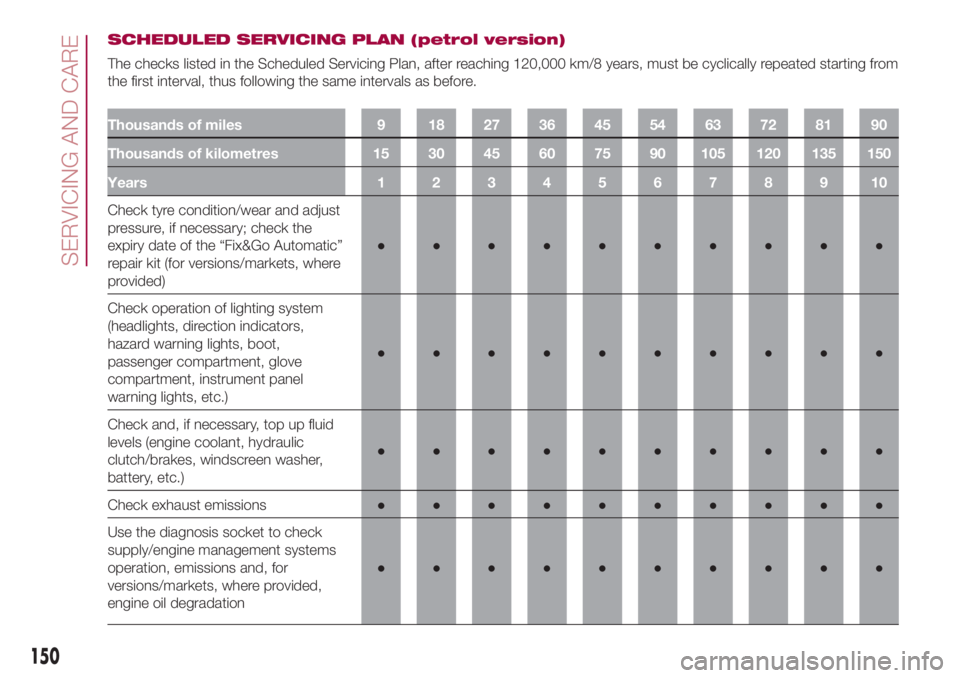
SCHEDULED SERVICING PLAN (petrol version)
The checks listed in the Scheduled Servicing Plan, after reaching 120,000 km/8 years, must be cyclically repeated starting from
the first interval, thus following the same intervals as before.
Thousands of miles 9 18 27 36 45 54 63 72 81 90
Thousands of kilometres 15 30 45 60 75 90 105 120 135 150
Years12345678910
Check tyre condition/wear and adjust
pressure, if necessary; check the
expiry date of the “Fix&Go Automatic”
repair kit (for versions/markets, where
provided)●●●●●●●●●●
Check operation of lighting system
(headlights, direction indicators,
hazard warning lights, boot,
passenger compartment, glove
compartment, instrument panel
warning lights, etc.)●●●●●●●●●●
Check and, if necessary, top up fluid
levels (engine coolant, hydraulic
clutch/brakes, windscreen washer,
battery, etc.)●●●●●●●●●●
Check exhaust emissions●●●●●●●●●●
Use the diagnosis socket to check
supply/engine management systems
operation, emissions and, for
versions/markets, where provided,
engine oil degradation●●●●●●●●●●
150
SERVICING AND CARE
Page 158 of 268
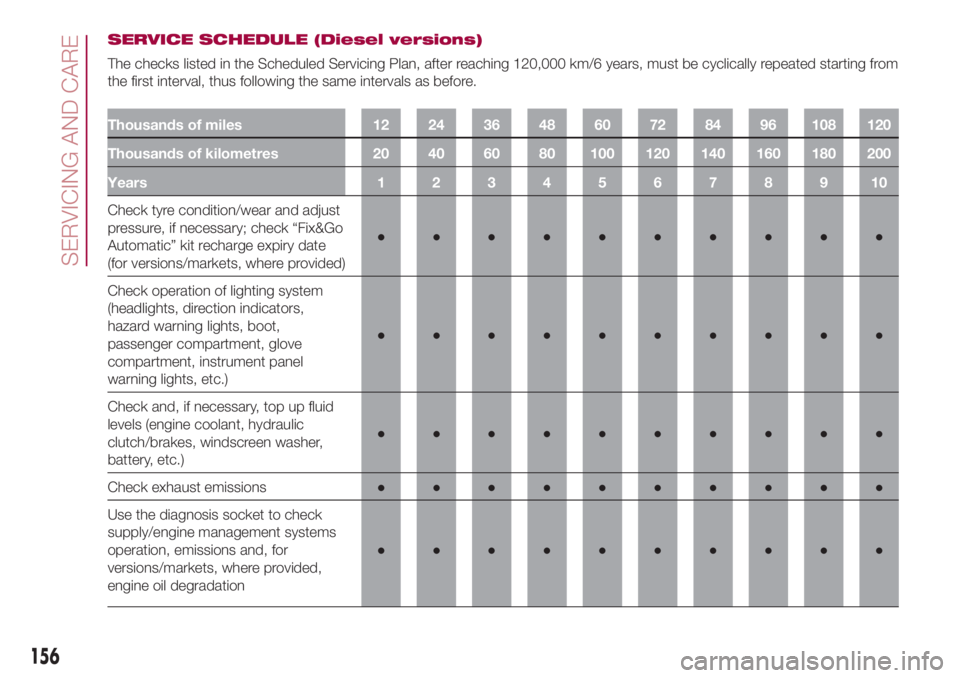
SERVICE SCHEDULE (Diesel versions)
The checks listed in the Scheduled Servicing Plan, after reaching 120,000 km/6 years, must be cyclically repeated starting from
the first interval, thus following the same intervals as before.
Thousands of miles 12 24 36 48 60 72 84 96 108 120
Thousands of kilometres 20 40 60 80 100 120 140 160 180 200
Years12345678910
Check tyre condition/wear and adjust
pressure, if necessary; check “Fix&Go
Automatic” kit recharge expiry date
(for versions/markets, where provided)●●●●●●●●●●
Check operation of lighting system
(headlights, direction indicators,
hazard warning lights, boot,
passenger compartment, glove
compartment, instrument panel
warning lights, etc.)●●●●●●●●●●
Check and, if necessary, top up fluid
levels (engine coolant, hydraulic
clutch/brakes, windscreen washer,
battery, etc.)●●●●●●●●●●
Check exhaust emissions●●●●●●●●●●
Use the diagnosis socket to check
supply/engine management systems
operation, emissions and, for
versions/markets, where provided,
engine oil degradation●●●●●●●●●●
156
SERVICING AND CARE
Page 160 of 268
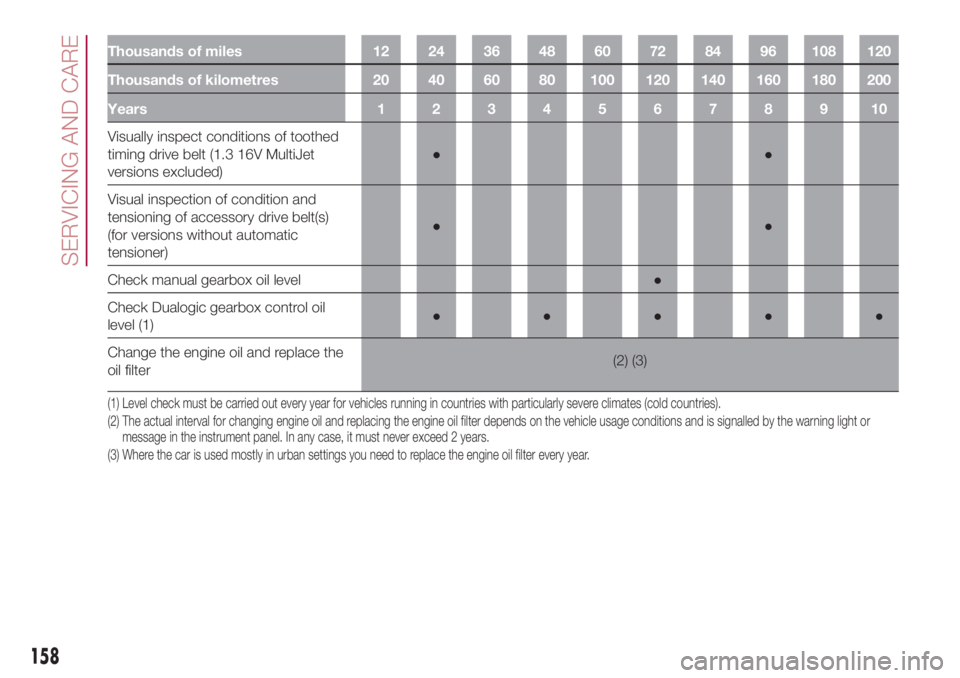
Thousands of miles 12 24 36 48 60 72 84 96 108 120
Thousands of kilometres 20 40 60 80 100 120 140 160 180 200
Years12345678910
Visually inspect conditions of toothed
timing drive belt (1.3 16V MultiJet
versions excluded)●●
Visual inspection of condition and
tensioning of accessory drive belt(s)
(for versions without automatic
tensioner)●●
Check manual gearbox oil level●
Check Dualogic gearbox control oil
level (1)●●●●●
Change the engine oil and replace the
oil filter(2) (3)
(1) Level check must be carried out every year for vehicles running in countries with particularly severe climates (cold countries).
(2) The actual interval for changing engine oil and replacing the engine oil filter depends on the vehicle usage conditions and is signalled by the warning light or
message in the instrument panel. In any case, it must never exceed 2 years.
(3) Where the car is used mostly in urban settings you need to replace the engine oil filter every year.
158
SERVICING AND CARE
Page 168 of 268
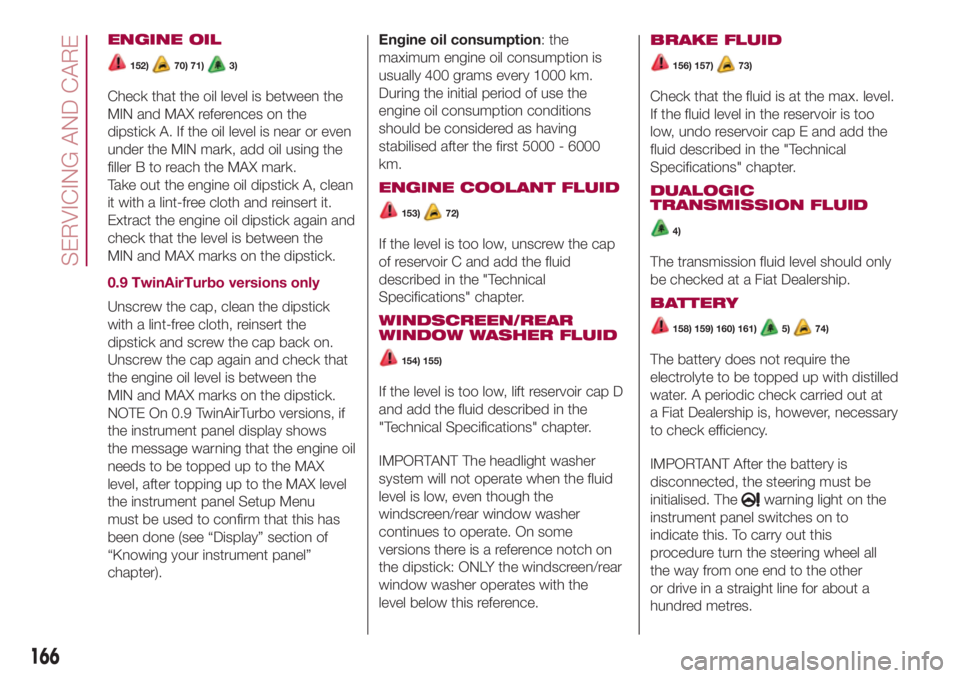
ENGINE OIL
152)70) 71)3)
Check that the oil level is between the
MIN and MAX references on the
dipstick A. If the oil level is near or even
under the MIN mark, add oil using the
filler B to reach the MAX mark.
Take out the engine oil dipstick A, clean
it with a lint-free cloth and reinsert it.
Extract the engine oil dipstick again and
check that the level is between the
MIN and MAX marks on the dipstick.
0.9 TwinAirTurbo versions only
Unscrew the cap, clean the dipstick
with a lint-free cloth, reinsert the
dipstick and screw the cap back on.
Unscrew the cap again and check that
the engine oil level is between the
MIN and MAX marks on the dipstick.
NOTE On 0.9 TwinAirTurbo versions, if
the instrument panel display shows
the message warning that the engine oil
needs to be topped up to the MAX
level, after topping up to the MAX level
the instrument panel Setup Menu
must be used to confirm that this has
been done (see “Display” section of
“Knowing your instrument panel”
chapter).Engine oil consumption: the
maximum engine oil consumption is
usually 400 grams every 1000 km.
During the initial period of use the
engine oil consumption conditions
should be considered as having
stabilised after the first 5000 - 6000
km.
ENGINE COOLANT FLUID
153)72)
If the level is too low, unscrew the cap
of reservoir C and add the fluid
described in the "Technical
Specifications" chapter.
WINDSCREEN/REAR
WINDOW WASHER FLUID
154) 155)
If the level is too low, lift reservoir cap D
and add the fluid described in the
"Technical Specifications" chapter.
IMPORTANT The headlight washer
system will not operate when the fluid
level is low, even though the
windscreen/rear window washer
continues to operate. On some
versions there is a reference notch on
the dipstick: ONLY the windscreen/rear
window washer operates with the
level below this reference.BRAKE FLUID
156) 157)73)
Check that the fluid is at the max. level.
If the fluid level in the reservoir is too
low, undo reservoir cap E and add the
fluid described in the "Technical
Specifications" chapter.
DUALOGIC
TRANSMISSION FLUID
4)
The transmission fluid level should only
be checked at a Fiat Dealership.
BATTERY
158) 159) 160) 161)5)74)
The battery does not require the
electrolyte to be topped up with distilled
water. A periodic check carried out at
a Fiat Dealership is, however, necessary
to check efficiency.
IMPORTANT After the battery is
disconnected, the steering must be
initialised. The
warning light on the
instrument panel switches on to
indicate this. To carry out this
procedure turn the steering wheel all
the way from one end to the other
or drive in a straight line for about a
hundred metres.
166
SERVICING AND CARE
Page 175 of 268

wipe a sponge with a slightly soapy
solution over the bodywork, frequently
rinsing the sponge;
rinse well with water and dry with a
jet of air or a chamois leather.
WARNING
81)In order to preserve the aesthetic
appearance of the paint abrasive products
and/or polishes should not be used for
cleaning the vehicle.
82)Avoid washing with rollers and/or
brushes in washing stations. Wash the car
only by hand using neutral pH detergents;
dry it with a wet chamois leather. Abrasive
products and/or polishes should not be
used for cleaning the car. Bird droppings
must be washed off immediately and
thoroughly as the acid they contain
is particularly aggressive. Avoid (if at all
possible) parking the vehicle under trees;
remove vegetable resins immediately
as, when dried, it may only be possible to
remove them with abrasive products
and/or polishes, which is highly inadvisable
as they could alter the typical opaqueness
of the paint. Do not use pure windscreen
washer fluid for cleaning the front
windscreen and rear window; dilute it min.
50% with water. Only use pure screen
washer fluid when strictly necessary due to
outside temperature conditions.
WARNING
6)Detergents pollute the water. Only wash
your car in areas equipped to collect and
treat wastewater from this type of activity.
173
Page 233 of 268
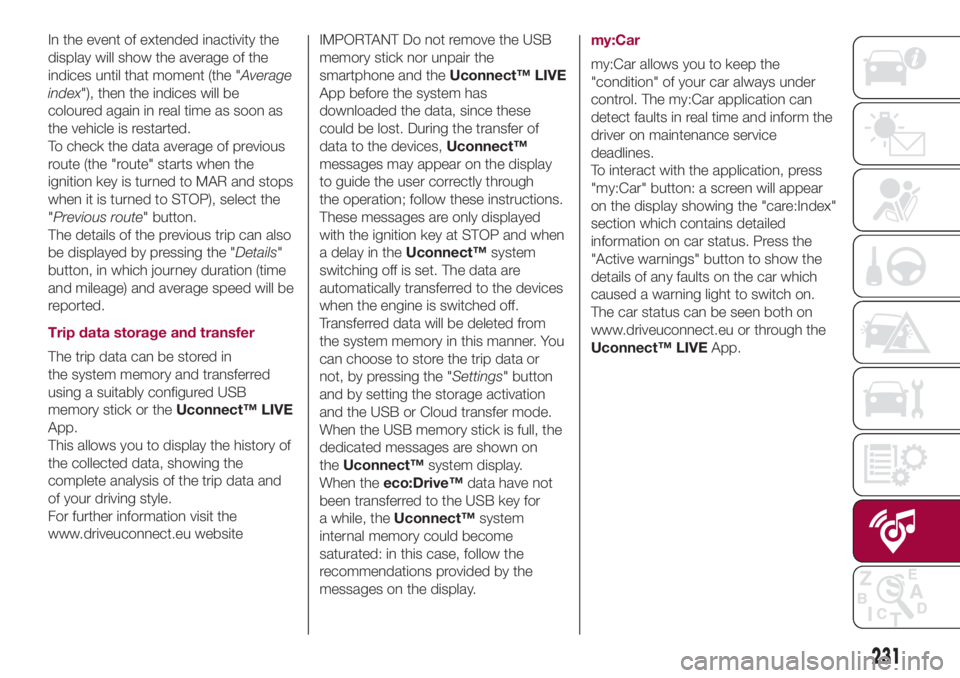
In the event of extended inactivity the
display will show the average of the
indices until that moment (the "Average
index"), then the indices will be
coloured again in real time as soon as
the vehicle is restarted.
To check the data average of previous
route (the "route" starts when the
ignition key is turned to MAR and stops
when it is turned to STOP), select the
"Previous route" button.
The details of the previous trip can also
be displayed by pressing the "Details"
button, in which journey duration (time
and mileage) and average speed will be
reported.
Trip data storage and transfer
The trip data can be stored in
the system memory and transferred
using a suitably configured USB
memory stick or theUconnect™ LIVE
App.
This allows you to display the history of
the collected data, showing the
complete analysis of the trip data and
of your driving style.
For further information visit the
www.driveuconnect.eu websiteIMPORTANT Do not remove the USB
memory stick nor unpair the
smartphone and theUconnect™ LIVE
App before the system has
downloaded the data, since these
could be lost. During the transfer of
data to the devices,Uconnect™
messages may appear on the display
to guide the user correctly through
the operation; follow these instructions.
These messages are only displayed
with the ignition key at STOP and when
a delay in theUconnect™system
switching off is set. The data are
automatically transferred to the devices
when the engine is switched off.
Transferred data will be deleted from
the system memory in this manner. You
can choose to store the trip data or
not, by pressing the "Settings" button
and by setting the storage activation
and the USB or Cloud transfer mode.
When the USB memory stick is full, the
dedicated messages are shown on
theUconnect™system display.
When theeco:Drive™data have not
been transferred to the USB key for
a while, theUconnect™system
internal memory could become
saturated: in this case, follow the
recommendations provided by the
messages on the display.my:Car
my:Car allows you to keep the
"condition" of your car always under
control. The my:Car application can
detect faults in real time and inform the
driver on maintenance service
deadlines.
To interact with the application, press
"my:Car" button: a screen will appear
on the display showing the "care:Index"
section which contains detailed
information on car status. Press the
"Active warnings" button to show the
details of any faults on the car which
caused a warning light to switch on.
The car status can be seen both on
www.driveuconnect.eu or through the
Uconnect™ LIVEApp.
231
Page 248 of 268

my:Car
my:Car allows you to keep the
condition of your car always under
control. The my:Car application can
detect faults in real time and inform the
driver on maintenance service
deadlines.
To interact with the application, press
"my:Car" button: a screen will appear
on the display showing the "care:Index"
section which contains detailed
information on car status. Press the
"Active warnings" button to show the
details of any faults on the car which
caused a warning light to switch on.
The car status can be seen both on
www.driveuconnect.eu or through the
Uconnect™ LIVEApp.Apple CarPlay and
Android Auto
(for versions/markets, where provided)
The Apple CarPlay and Android Auto
applications allow you to use your
smartphone in the car safely and
intuitively. To enable them, connect a
compatible smartphone via the USB
port and the contents of the phone will
be automatically shown on the
Uconnect™display.
To check the compatibility of your
smartphone, see the indications on the
websites: https://www.android.com/
intl/it_it/auto/ and http://
www.apple.com/it/ios/carplay/.
If the smartphone is connected
correctly to the car via the USB port,
the Apple CarPlay or Android Auto icon
will be displayed in place of the
button in the main menu.Android Auto APP Setup
Before use, download the Android Auto
application to your smartphone from
Google Play Store.
The application is compatible with
Android 5.0 (Lollipop) and later
versions. To use Android Auto, the
smartphone must be connected to the
car with a USB cable.
On the first connection, you will have to
perform the setup procedure prompted
by the smartphone. You can only
perform this procedure with the vehicle
stationary.
Once connected to the USB port, the
Android Auto application establishes
a parallelBluetooth® connection.
Apple CarPlay App Setup
Apple CarPlay is compatible with the
iPhone 5 or more recent models, with
the iOS 7.1 operating system or later
versions. Before using Apple CarPlay,
enable Siri from Settings > General
> Siri on the smartphone.
To use Apple CarPlay, the smartphone
must be connected to the car with a
USB cable.
246
MULTIMEDIA
Page 254 of 268

IMPORTANT INFORMATION AND RECOMMENDATIONS
WARNING
INTERIOR FITTINGS
Do not travel with the storage compartments open: they may injure the front seat occupants in the event of an accident.
The cigar lighter gets extremely hot. Handle it carefully and make sure that children don’t use it: risk of fire and/or burns.
ROOF RACK/SKI RACK
After travelling for a few kilometres, check to ensure that the fixing screws for the attachments are well tightened.
Never exceed the maximum permitted loads (see chapter "Technical specifications").
Evenly distribute the load and take into account, when driving, the increased responsiveness of the vehicle to side wind.
INTERIOR
Ever use flammable products, such as petrol ether or rectified petrol to clean the inside of the car. The electrostatic charges which are
generated by rubbing during the cleaning operation may cause a fire.
Do not keep aerosol cans in the car: they might explode. Aerosol cans must not be exposed to a temperature exceeding 50°C. When the
vehicle is exposed to sunlight, the internal temperature can greatly exceed this value.
It is essential that there is nothing under the pedals: make sure the mats are lying flat and do not get in the way of the pedals.
POWER SUPPLY
Modifications or repairs to the fuel system that are not carried out correctly or do not take the system technical specifications into account
can cause malfunctions leading to the risk of fire.
WARNING
ROOF RACK/SKI RACK
Fully comply with the regulations in force concerning maximum clearance.
INTERIOR
Never use alcohol, petrols and derivatives to clean the dashboard and instrument panel lens.
252
MULTIMEDIA
Page 263 of 268
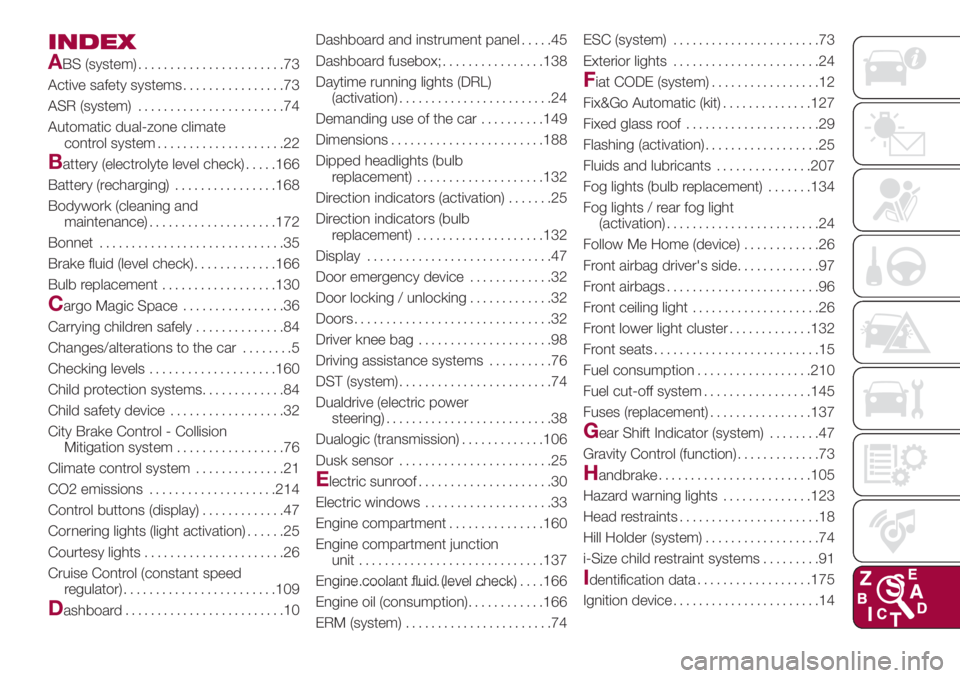
INDEX
A
BS (system).......................73
Active safety systems................73
ASR (system).......................74
Automatic dual-zone climate
control system....................22
Battery (electrolyte level check).....166
Battery (recharging)................168
Bodywork (cleaning and
maintenance)....................172
Bonnet.............................35
Brake fluid (level check).............166
Bulb replacement..................130
Cargo Magic Space................36
Carrying children safely..............84
Changes/alterations to the car........5
Checking levels....................160
Child protection systems.............84
Child safety device..................32
City Brake Control - Collision
Mitigation system.................76
Climate control system..............21
CO2 emissions....................214
Control buttons (display).............47
Cornering lights (light activation)......25
Courtesy lights......................26
Cruise Control (constant speed
regulator)........................109
Dashboard.........................10Dashboard and instrument panel . . . . .45
Dashboard fusebox;................138
Daytime running lights (DRL)
(activation)........................24
Demanding use of the car..........149
Dimensions........................188
Dipped headlights (bulb
replacement)....................132
Direction indicators (activation).......25
Direction indicators (bulb
replacement)....................132
Display.............................47
Door emergency device.............32
Door locking / unlocking.............32
Doors...............................32
Driver knee bag.....................98
Driving assistance systems..........76
DST (system)........................74
Dualdrive (electric power
steering)..........................38
Dualogic (transmission).............106
Dusk sensor........................25
Electric sunroof.....................30
Electric windows....................33
Engine compartment...............160
Engine compartment junction
unit.............................137
Engine coolant fluid (level check).................................166
Engine oil (consumption)............166
ERM (system).......................74ESC (system).......................73
Exterior lights.......................24
Fiat CODE (system).................12
Fix&Go Automatic (kit)..............127
Fixed glass roof.....................29
Flashing (activation)..................25
Fluids and lubricants...............207
Fog lights (bulb replacement).......134
Fog lights / rear fog light
(activation)........................24
Follow Me Home (device)............26
Front airbag driver's side.............97
Front airbags........................96
Front ceiling light....................26
Front lower light cluster.............132
Front seats..........................15
Fuel consumption..................210
Fuel cut-off system.................145
Fuses (replacement)................137
Gear Shift Indicator (system)........47
Gravity Control (function).............73
Handbrake........................105
Hazard warning lights..............123
Head restraints......................18
Hill Holder (system)..................74
i-Size child restraint systems.........91
Identification data..................175
Ignition device.......................14